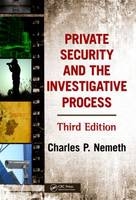
Private Security and the Investigative Process
Auerbach (Verlag)
978-1-4200-8569-3 (ISBN)
- Titel erscheint in neuer Auflage
- Artikel merken
Detailing best practices and trade secrets for private sector security investigations, Private Security and the Investigative Process, Third Edition provides complete coverage of the investigative process. Fully updated, this edition covers emerging technology, revised legal and practical considerations for conducting interviews, and new information on case evaluation.
Written by a recognized expert in security, criminal justice, ethics, and the law—with over three decades of experience—the updated edition of this popular text covers concepts and techniques that can be applied to a variety of investigations including fraud, insurance, private, and criminal. It details the collection and preservation of evidence, the handling of witnesses, surveillance techniques, background investigations, and report writing. This new edition includes:
More than 80 new or updated forms, checklists, charts, and illustrations
Updated proprietary information from Pinkerton, Wackenhut, and other leading security companies
Increased emphasis on software and technological support products
A closer examination of periodical literature and government publications
Authoritative, yet accessible, this book is an important reference for private investigators and security professionals. Complete with numerous forms, checklists, and web exercises, it provides the tools and understanding required to conduct investigations that are professional, ethical, and effective.
Charles P. Nemeth JD, Ph.D, LL.M, Chair and Professor of Legal Studies, Homeland Security and Criminal Justice,California University of Pennsylvania, California, Pennsylvania, USA
Introduction to the Private Security Industry and the Investigative Process
The Trend toward Privatization
The Investigative Process: Private Security’s Role
Types of Investigative Activities
General Investigative Methods
General Characteristics of a Competent Investigator Introduction
Introduction
Objectivity and Investigative Practice
Logic and Investigative Practice
Perseverance, Diligence, and Investigative Practice
Human Relations Skills and Investigative Practice
Ethics and the Investigative Process
Initial Interview and Case Evaluation
Introduction
Initial Interview
Miscellaneous Matters at Initial Interview
Recording Interview Impressions
Case Evaluation
Witnesses
The Purpose of Witnesses
Types of Witnesses
Missing or Unknown Witnesses
Lay Witnesses
Expert Witnesses
Character Witnesses
Processing Witnesses
Conclusion
Collection of Information
The Nature of Information and the Rules of Collection
Leads and Contacts for the Private Investigator
Public Sources of Information
Federal Agencies
State and Local Agencies
Private Sources of Information
Directories, Databases, and Atlases
Libraries
Newspapers
The Internet
Professional Associations and Groups
Auto Records
The Background Investigation
Real Property Title Search
Collection of Evidence and Preservation of the Scene
Introduction
Preliminary Strategies and Responses
Scene Sketches and Other Graphic Portrayals
Rules for Sketching
Rules for Measuring
Photographic Evidence
Location of Crime Scene
Photography and Special Applications
Drug and Alcohol Abuse Evidence
Documentary Evidence
Police Records
Medical Records
Records Involving Economic Damages
Preservation of Evidence
Surveillance Techniques
Purposes and Functions
Tactics and Strategy in Surveillance
What Are the Steps of Surveillance?
What Is the Exact Objective of Surveillance?
Where Is the Location of Surveillance?
When Will Surveillance Occur
Who or What Will Be Surveilled?
Surveillance: Preparatory Steps
Personal Behavior and Attire
Surveillance Equipment
Types of Surveillance
Stationary Surveillance
Moving Surveillance
Hybrid and Other Special Surveillance Techniques
Surveillance Forms and Reports
Report Writing
Introduction
Efficiency in the Investigative Process
Reports and Memory
Reports and Organizational Method during the Investigation
Reports as Proof of Services Rendered
Characteristics of Solid Report Writing
The Role of Note Taking
The Essential Qualities of a Solid Report: Accurate, Brief, and Complete
Report Design or Format
Standard Reports for the Private Investigator
Activity Reports
Major Criminal Documentation
Investigative Method and Technique: Theft/Property Offenses
Introduction
Shoplifting
Rationalizations and Justifications for Shoplifting
Shoplifting Methods
Internal Theft by Employees
Reasons for Theft
Theft Strategies
Investigating Theft
Obtaining Confessions or Statements
Burglary
Defensive Techniques to Minimize and Identify Burglary and Property Losses
Tactics and Strategies
Missing or Stolen Property
Investigative Method and Technique: Insurance Cases
Introduction
Application and Method
Property Claim for Cases of Arson
Workers’ Compensation
Disability Claims
Auto Liability Claims
Special Problems: Auto Theft, Fraud, and Parts Pilferage
Auto Identification Systems
Investigative Method and Technique: Background Investigations
Introduction
Background Issues
Establishing Identity
Employment History
Credit History
Alternative Methods of Background Review
References
Consultative Services
The Polygraph Test
Comprehensive Background Report
The Security Office: Administrative Issues
Some General Principles of Office Administration
Time-Keeping Methods
The Value of Administrative Documents
Filing Systems
Set-Up and Maintenance
Tickler Files
Software Considerations
Billing
Conclusion
Index
Each chapter concludes with a "Notes" section
| Erscheint lt. Verlag | 9.2.2010 |
|---|---|
| Zusatzinfo | PPI 500; SEE NOTES!!!!; 1 Tables, black and white; 307 Illustrations, black and white |
| Verlagsort | London |
| Sprache | englisch |
| Maße | 178 x 254 mm |
| Gewicht | 930 g |
| Themenwelt | Sozialwissenschaften ► Soziologie |
| ISBN-10 | 1-4200-8569-7 / 1420085697 |
| ISBN-13 | 978-1-4200-8569-3 / 9781420085693 |
| Zustand | Neuware |
| Haben Sie eine Frage zum Produkt? |
aus dem Bereich



